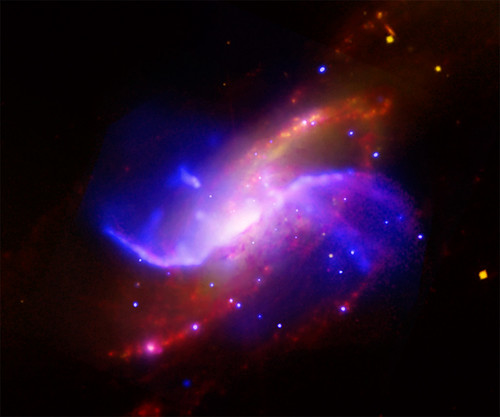Teaming Up with Hubble to Create Beauty
- By Maggie Masetti
- February 7, 2013
- Comments Off on Teaming Up with Hubble to Create Beauty
Capturing the beauty of this galaxy took a team of people – and to understand the galaxy takes a team of missions.
This gorgeous image of galaxy M106 was created by renowned astro-photographer Robert Gendler, who retrieved archival Hubble images to assemble a mosaic of the center of the galaxy. He then used his own and fellow astro-photographer Jay GaBany’s observations to fill in areas where there was little or no Hubble data.

Credit: NASA, ESA, the Hubble Heritage Team (STScI/AURA), and R. Gendler (for the Hubble Heritage Team) Acknowledgment: J. GaBany
The NASA feature written about this image tells us that Hubble data from the Advanced Camera for Surveys, Wide Field Camera 3, and Wide Field Planetary Camera 2 detectors were used for the center of the galaxy. The outer spiral arms are also Hubble data, but colorized with ground-based data taken by Gendler’s and GaBany’s 12.5-inch and 20-inch telescopes, which was captured at dark, remote sites in New Mexico.
Also visible are the optical component of the so-called “anomalous arms” of M106, which in this image are a red color, from glowing hydrogen emission. They’re called “anomalous” because they don’t line up very well with the galaxy’s more prominent spiral arms.
Why is this hydrogen gas glowing?
Much like other big galaxies, the center of this galaxy contains a supermassive black hole. As matter falls into it, it creates a disc (called an accretion disk) around the black hole. This matter is subject to extreme conditions, like heat at temperatures of millions of degrees and superstrong magnetic fields. As a result, some of this matter gets blasted away from the black hole in jets. The jets generally are perpendicular (up and down, really) to the plane of the disc of matter. In the case of M106, the accretion disk is actually tipped from the plane of the galaxy. That means the jets are being blasted from the black hole at enough of an angle (30 degrees) that instead of just rocketing up (and down) into space, they are slamming into other matter in the galaxy. When gaseous hydrogen is hit by these violent impacts, it heats up and glows red!
We thought it was an interesting exercise to compare the above image with this one, which is infrared data from Spitzer and X-ray data from Chandra.

In this composite image of spiral galaxy M106 (NGC 4258), optical data from the Digitized Sky Survey is shown as yellow, radio data from the Very Large Array appears as purple, X-ray data from Chandra is coded blue, and infrared data from the Spitzer Space Telescope appears red. Two anomalous arms, which aren’t visible at optical wavelengths, appear as purple and blue emission. Credit: X-ray: NASA/CXC/Univ. of Maryland/A.S. Wilson et al.; Optical: Palomar Observatory. DSS; IR:NASA/JPL-Caltech; VLA: NRAO/AUI/NSF
Phil Plait tells us more in his blog on M106:
In the Hubble image [the anomalous arms] emit a bit of red light due to the prevalent hydrogen. But when you look at M106 using the Spitzer (which sees in infrared) and Chandra (X-rays) space telescopes, the picture is clearer. X-rays are generated in very violent events. In this case, shock waves created when the high-speed material slams into the relatively stationary gas heats that material to well over a million degrees, which then emits X-rays. This super-heated matter in turn heats up material around it, making it glow in infrared, too. That’s no surprise, since the jets blast out X-ray energy at a rate millions of times more luminous than our Sun.
All of that activity sure makes one amazingly beautiful picture of an amazingly beautiful galaxy!


